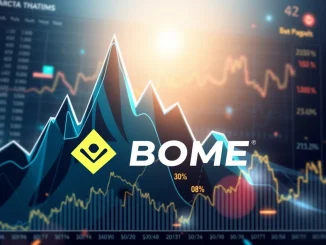
Understanding the pulse of the cryptocurrency market is crucial for any trader or investor. One powerful way to gauge this sentiment, especially for Bitcoin, is by looking at the **BTC perpetual futures** market. Specifically, analyzing the **long-short ratio** can offer valuable insights into whether traders are leaning bullish or bearish. Let’s dive into the recent **crypto trading data** from the top exchanges to see what the current sentiment looks like.
Decoding the Latest **BTC Perpetual Futures** Ratios
Over the past 24 hours, the **BTC perpetual futures** market has shown a fascinating balance between traders betting on price increases (longs) and those betting on decreases (shorts). We’ve compiled the **long-short ratio** data from three of the largest cryptocurrency derivatives exchanges: Binance, OKX, and Bybit, based on open interest.
Here’s a snapshot of the situation:
| Exchange/Total | Long % | Short % |
|---|---|---|
| Total Across Exchanges | 50.64% | 49.36% |
| Binance | 50.57% | 49.43% |
| OKX | 51.67% | 48.33% |
| Bybit | 50.54% | 49.46% |
As you can see from this **Binance OKX Bybit data**, the overall market is split almost down the middle, with a slight edge to the long positions. Each individual exchange also reflects this tight balance, though OKX shows a slightly stronger lean towards longs compared to Binance and Bybit.
What Does This **Long-Short Ratio** Tell Us About **Bitcoin Market Sentiment**?
The **long-short ratio** is a derivative metric calculated by dividing the total open interest of long positions by the total open interest of short positions on futures contracts. A ratio above 1 indicates that there are more long positions than short positions, suggesting a generally bullish sentiment. A ratio below 1 suggests more short positions, pointing towards a bearish sentiment.
When the ratio is very close to 1 (as it is now, with the total being roughly 1.02:1), it typically indicates:
- Indecision: Traders are not strongly convinced of a clear upward or downward trend in **BTC perpetual futures**.
- Balanced Market: Buying and selling pressures are relatively equal, leading to potential consolidation or range-bound price action.
- Lack of Strong Conviction: Unlike times when the ratio might be heavily skewed (e.g., 70% longs or 60% shorts), the current data doesn’t signal overwhelming bullish or bearish sentiment across these major platforms based on this specific metric.
Why is This **Crypto Trading Data** Important?
Tracking metrics like the **long-short ratio** offers traders and analysts a window into the collective psychology of the market participants trading **BTC perpetual futures**. While not a crystal ball, it’s a key piece of the puzzle when trying to understand potential future price movements.
Benefits of monitoring this data include:
- Gauging Sentiment: Directly see if the majority of leveraged traders are positioned long or short.
- Identifying Potential Reversals: Sometimes, extreme ratios can act as a contrarian indicator. If everyone is heavily long, who is left to buy? This could precede a potential price drop (a ‘long squeeze’). Conversely, an extremely low ratio might precede a ‘short squeeze’. The current balanced ratio doesn’t suggest an imminent squeeze based *solely* on this metric.
- Comparing Exchanges: Looking at **Binance OKX Bybit data** individually can reveal nuances or differences in trader behavior across platforms, though in this case, they are quite similar.
Challenges and Considerations
While insightful, relying solely on the **long-short ratio** for trading decisions isn’t advisable. Here are a few things to keep in mind:
- Lagging Indicator: The ratio reflects positions already taken, not necessarily future intentions.
- Whale Influence: Large institutional or individual traders (whales) can open significant positions that might skew the ratio without necessarily leading to a sustained price move if their positions are part of complex strategies (like hedging spot holdings).
- One Metric Among Many: This data is best used in conjunction with other forms of analysis, such as price action, volume, funding rates, and on-chain data.
Actionable Insights from the Current Ratios
Given the current balanced **long-short ratio** across **BTC perpetual futures** on major exchanges like Binance, OKX, and Bybit, what can traders take away?
The data suggests a period of equilibrium. This might mean:
- Caution: Without a strong directional bias from leveraged traders, volatility might be lower, or price could move sideways.
- Focus on Other Indicators: Since the sentiment signal from this ratio is neutral, traders might place more emphasis on chart patterns, support/resistance levels, or macroeconomic factors.
- Prepare for Shifts: Monitor how this ratio evolves. A significant shift towards longs or shorts could signal growing conviction in one direction.
Conclusion: A Market in Balance Based on Futures Data
The latest **crypto trading data** on **BTC perpetual futures** from major platforms like Binance, OKX, and Bybit reveals a market currently split almost evenly between bullish and bearish sentiment, as indicated by the **long-short ratio**. This critical balance suggests indecision or equilibrium among leveraged traders.
While this metric is a valuable tool for understanding **Bitcoin market sentiment**, remember it’s just one piece of the puzzle. Combining this **Binance OKX Bybit data** with other technical and fundamental analysis methods will provide a more comprehensive view and help navigate the fascinating, often unpredictable, world of cryptocurrency trading.



